Loan-To-Value Ratio In Simple Words

If you’re reading this post, you’ve probably heard about Loan-To-Value ratio (LTV). If you’ve ever borrowed on CoinLoan, you had to choose your LTV. But did you really understand how that ratio work?
Is your answer “no”? You’re not alone.
WTF Is LTV
Crypto performs perfectly as collateral. Unlike a traditional collateral scheme, there’s no need to verify the borrower’s solvency and arrange the collateral assessment.
But it’s not all rosy when crypto starts to fluctuate like crazy. In case the value of active loan collateral falls, the investor remains unprotected. Fortunately, the problem has a simple solution called LTV ratio. It’s a common thing in asset-backed lending to secure your loan with higher-value collateral (overcollateralization). A ratio between the amount of your loan and the market value of your collateral is a Loan-to-Value ratio (LTV).
How to Calculate LTV
The LTV formula is:
LTV = (Size of Loan) / (Collateral Value)
To determine your LTV, you simply divide your loan amount by the value of the collateral asset. For instance, to get €100,000 depositing 55 BTC, you need to determine your crypto value first. At current rates, 1 BTC ≈ $3,500, it means that the market value of 55 BTC is about $192,500.
Now enter 100,000 on your calculator and divide it by 192,500. You’ll get 0,52 or 52%. This is your LTV ratio.
If you want to count the amount of fiat you can borrow against your crypto, you should reverse the formula:
(Size of Loan) = LTV * (Collateral Value)
For instance, you’ve got 57 BTC, 1 BTC ≈ $3,500, so all your crypto market value is $200,000. Maximum LTV available on the CoinLoan platform is 70%. So you’re to multiply 200,000 by 0,6 equals 120,000. You’re able to borrow up to $120,000.
How It Works on CoinLoan
In traditional collateral-based lending, LTV is a measure of risk for the investor. The higher the LTV, the higher the risk for the lender (and therefore the higher the interest rate for the borrower). That’s not the way it works at the CoinLoan platform. Cryptocollateral ensures full repayment in time; it reduces investor’s risks. If something goes wrong with the monthly repayment, we’ll sell a part of the borrower's collateral to make a payment for them.
So choosing the LTV ratio as a borrower, you determine your own risk first of all. Creating a Loan Request (Borrowing Application), you can set up an LTV ratio in the range from 5% to 70%. Lower LTV means you have a safety bag. In case of a market fall, your crypto is not likely to be liquidated to secure a lender’s investment. Higher LTV means that you will have to act fast in case of an extraordinary market situation. Good news is that CoinLoan won’t give you a chance to miss out on this.
LTV and Margin Call
A few days before your monthly payment or in case of critical changes in your cryptocollateral value, you’ll get email notifications.
If you forget to make a payment according to your schedule, we’ll make it automatically if you have enough of fiat currency needed on your CoinLoan wallet. Otherwise, we’ll be forced to sell a part of your collateral to complete the payment.
In case your collateral market value falls, your LTV grows. Then you can repay the loan earlier or add extra collateral. If you do nothing and the LTV ratio of the loan reaches 91%, we’ll sell your cryptocollateral in full to bring the situation back into balance.
If the opposite happened and your loan value grew up, you’re free to withdraw a part of crypto from an active overcollateralized loan.
Thanks for reading, we hope that makes more sense now! Hit the clap button to make this article go 🚀
Platform | Website | Telegram | Email | Facebook | Twitter | Reddit